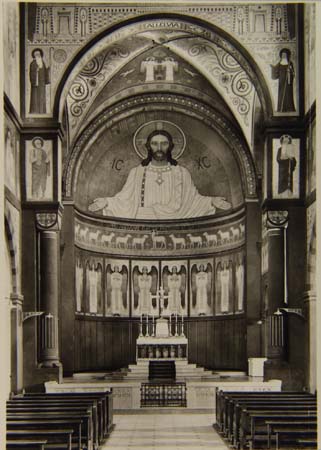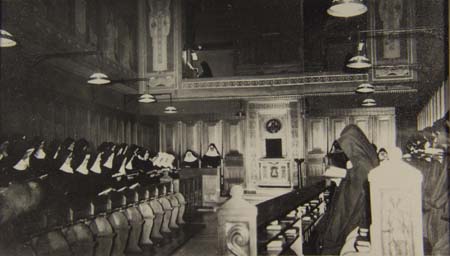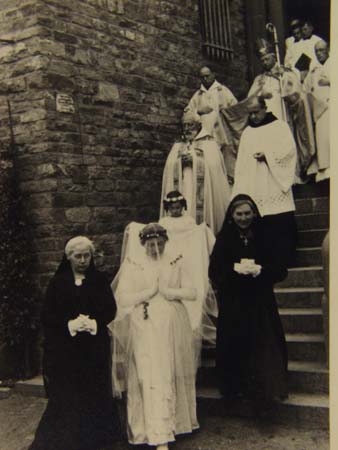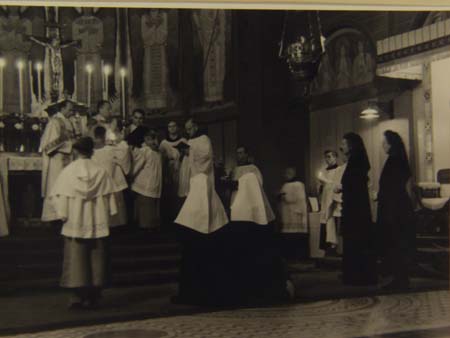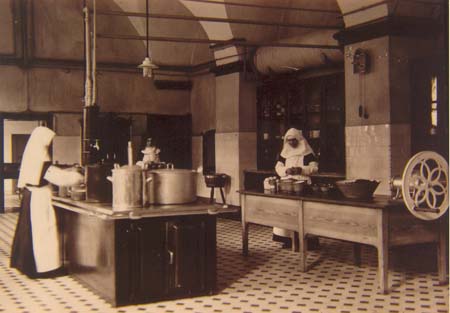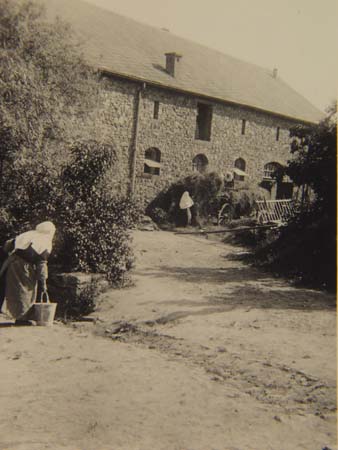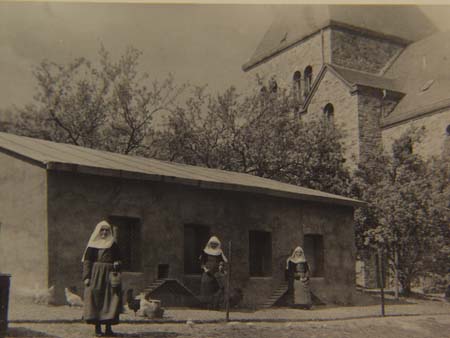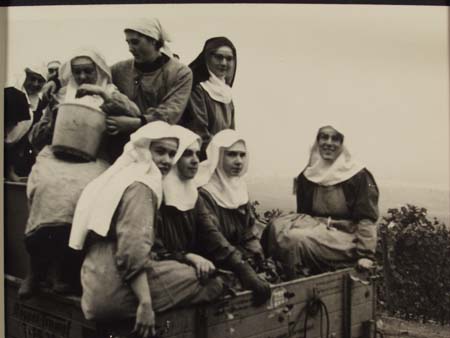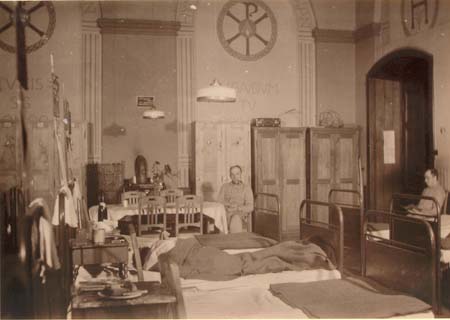 The Abbey of St. Hildegard through the Ages
The Abbey of St. Hildegard through the Ages
Our monastery, the Abbey of St Hildegard, is situated above Rüdesheim and the Rhine river. Some think it is a Romanesque building, but it was only built at the beginning of the 20th century. However, we think of our house as a foundation of St Hildegard, going back to the old convent of Eibingen.
In the year 1150 Hildegard of Bingen built her first monastic house at Rupertsberg at the mouth of the river Nahe near Bingen. When the number of vocations steadily increased and more and more young women gathered around her, Hildegard bought the former Augustinian double monastery of Eibingen near Rüdesheim. She took on the leadership of the new foundation at Eibingen as well and crossed the Rhine twice a week until her death to visit the daughter house. After St Hildegard’s death on September 17th, 1179 both houses at Rupertsberg and Eibingen moved along with the course of history, seeing times of monastic life flourish and decline.
During the turmoil of the Thirty Year War, Rupertsberg was destroyed by the Swedes in 1632. The nuns had to flee, but returned in 1636. The monastic buildings were, however, in such a bad state of repair that rebuilding was out of the question. So the nuns of Rupertsberg sought refuge at the convent of Eibingen. In 1642 the last Rupertsberg Abbess, Anna Lerch von Dürmstein, resigned from her office. The subsequent 150 years were shaped by many afflictions. Famine, the plague, wars and destruction overtook Eibingen. In 1803 the convent was dissolved in the course of the secularization and the estate was lost. With this, monastic life in Eibingen came to an end. The convent church was taken over by the parish. It is for this reason that the relics of St Hildegard are venerated at the Eibingen church to this day. In 2002 one of our own nuns of the Abbey of St Hildegard took on pastoral care of pilgrims coming to Eibingen. In this way, the old and the new convent of Eibingen have a definite bond again.
PLANS FOR A NEW FOUNDATION
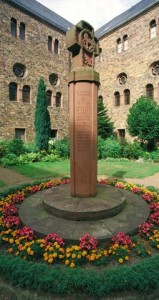 We owe the plan to found a new convent, which would revive the old religious house at Eibingen and also be a link to the one destroyed by the Swedes at Rupertsberg in 1632, to Bishop Peter Josef Blum of Limburg (1842-1883). Through his efforts and those of Ludwig Schneider, who was parish priest at Eibingen between 1840 to 1864, the veneration of St Hildegard received a new and decisive impulse in the 19th century. Bishop Blum, who was driven from his office during the Kulturkampf (struggle between the Prussian State and the Church 1872-87), was offered refuge by Prince Karl zu Löwenstein-Wertheim-Rosenberg at his castle Haid in Bohemia. The bishop’s successor, Dr Karl Klein, also had close ties with the royal family and involved them from the beginning in his plans to revive the old convent of Eibingen.
We owe the plan to found a new convent, which would revive the old religious house at Eibingen and also be a link to the one destroyed by the Swedes at Rupertsberg in 1632, to Bishop Peter Josef Blum of Limburg (1842-1883). Through his efforts and those of Ludwig Schneider, who was parish priest at Eibingen between 1840 to 1864, the veneration of St Hildegard received a new and decisive impulse in the 19th century. Bishop Blum, who was driven from his office during the Kulturkampf (struggle between the Prussian State and the Church 1872-87), was offered refuge by Prince Karl zu Löwenstein-Wertheim-Rosenberg at his castle Haid in Bohemia. The bishop’s successor, Dr Karl Klein, also had close ties with the royal family and involved them from the beginning in his plans to revive the old convent of Eibingen.
The prince took up the idea enthusiastically, as it meant a lot to him to be able to restore the secularized estate, which had been awarded to his family by the Reichsdeputationshauptschluß of 1803, to the church in this way. His oldest daughter Benedicta, a nun at the Abbey of St Cécile at Solesmes in France, was to be the first abbess of the convent to be re-founded. When she died unexpectedly on July 2nd, 1896 at the age of only 36, Prince Löwenstein nevertheless continued with his project and spared neither expense nor personal sacrifice for the rebuilding of the monastery.
The Abbey of St Hildegard was to be built on the slopes above the village of Eibingen. The building material – sandstone interspersed with quartzite – was taken from the hill above the building site. Fr Ludger Rincklage, a monk of the Abbey of Maria Laach and former architect, headed the planning and building work. On July 2nd, 1900, Arch-Abbot Placidus Wolter of Beuron, who traveled to the banks of the Rhine in place of Bishop Dominikus Willi, who had been taken ill, laid the foundation stone of the new monastery.
NEW BEGINNINGS OF MONASTIC LIFE
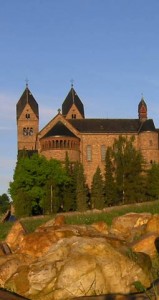 After four years of work, the monumental building was essentially complete. On September 17th, 1904, twelve Benedictine nuns moved into the new foundation from the Abbey of St Gabriel in Prague, the Beuron Congregation’s first monastic house for women. In 1908 the priory was raised to an Abbey by two decrees of Pope Leo XIII, and vested with all the rights and privileges of the former Abbey of St Hildegard. As an „exempt“ abbey it does not come under the jurisdiction of the regional bishop, but directly under the Holy See. On September 7th, 1908 the wall painting of the interior of the church, by Fr Paulus Krebs of Beuron and his students, was so far advanced that the bishop of Limburg, Dominikus Willi, could consecrate the church.
After four years of work, the monumental building was essentially complete. On September 17th, 1904, twelve Benedictine nuns moved into the new foundation from the Abbey of St Gabriel in Prague, the Beuron Congregation’s first monastic house for women. In 1908 the priory was raised to an Abbey by two decrees of Pope Leo XIII, and vested with all the rights and privileges of the former Abbey of St Hildegard. As an „exempt“ abbey it does not come under the jurisdiction of the regional bishop, but directly under the Holy See. On September 7th, 1908 the wall painting of the interior of the church, by Fr Paulus Krebs of Beuron and his students, was so far advanced that the bishop of Limburg, Dominikus Willi, could consecrate the church.
The day after the consecration of the church, on September 8th, 1908, Regintrudis Sauter, who had been prioress, was solemnly blessed as the first abbess of the new monastic community. With this she became the 36th successor to St Hildegard, under whose patronage the Abbey and church had been placed. The number of nuns increased steadily in the years following. The community came through the First World War (1914-1918) and the post war inflationary period relatively well, thanks to the wise leadership of the house. During the time after the First World War (1918-1939) the east wing of the Abbey, which so far had been a shell, could also be completed. The novitiate wing and chapter hall were officially opened.
THE ABBEY OF ST HILDEGARD IN THE SECOND WORLD WAR
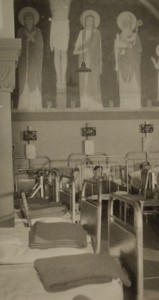 The time of the National Socialist regime and the Second World War brought many trials to the monastic community at the Abbey of St Hildegard. As early as May 1941, Abbess Regintrudis Sauter made part of the abbey buildings available as a military hospital and put twenty sisters at the disposal of the Wehrmacht as nurses, caring for the wounded, and for administrative work – in the hope of saving the abbey from being closed. This was not to be. On July 2nd, 1941, the 41st anniversary of the laying of the foundation stone, 115 nuns were expelled by the secret police force (Gestapo). The sisters had to leave the convent and the monastic estate was confiscated.
The time of the National Socialist regime and the Second World War brought many trials to the monastic community at the Abbey of St Hildegard. As early as May 1941, Abbess Regintrudis Sauter made part of the abbey buildings available as a military hospital and put twenty sisters at the disposal of the Wehrmacht as nurses, caring for the wounded, and for administrative work – in the hope of saving the abbey from being closed. This was not to be. On July 2nd, 1941, the 41st anniversary of the laying of the foundation stone, 115 nuns were expelled by the secret police force (Gestapo). The sisters had to leave the convent and the monastic estate was confiscated.
The majority of the community was received by various orders of charity, notably the congregations of Waldbreitenbach and Dernbach as well as the Borromaean sisters of Bingen. The Eibingen nuns worked in hospitals, nursing homes and other areas for the remaining years of the war. A small group of the Eibingen convent remained at St Hildegard to care for the wounded as Red Cross helpers or to take care of domestic matters at the military hospital with its 100-130 patients. Rüdesheim was largely destroyed in a bombing raid in November 1944, but the abbey buildings were spared. However, since the main military hospital and the operating theatre at Eibingen had been destroyed by bombs, the number of beds at the hospital’s branch in the abbey buildings was raised to 325. A few weeks before the end of the war, on March 19th, 1945 the military hospital at Eibingen was closed down. A few days later American troops moved into Rüdesheim. Soon the estate was returned to the convent. Parts of the monastic buildings were made available to senior citizens of Rüdesheim, who had been made homeless by the bombing raid, and also to accommodate refugees from the East of Germany for the next 10 years.
THE DEVELOPMENT OF THE ABBEY AFTER 1945
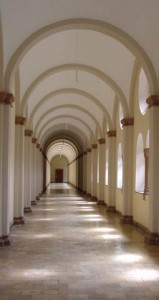 By July 2nd, 1945 – again the anniversary of the laying of the foundation stone – the Abbey buildings had been sufficiently repaired by the few sisters who had already returned and by many volunteers, so that the remainder of the expelled nuns could return home. On this day monastic life under the leadership of Abbess Regintrudis Sauter, now 80 years old, but still energetic, was taken up again. Many a young woman now asked for admission to the convent, so that with the steady increase in numbers the internal building-up of the community could also begin. In place of the bells, which had been confiscated during the war, four new bells were blessed by the Abbot of Maria Laach, Basilius Ebel, on July 1st, 1952.
By July 2nd, 1945 – again the anniversary of the laying of the foundation stone – the Abbey buildings had been sufficiently repaired by the few sisters who had already returned and by many volunteers, so that the remainder of the expelled nuns could return home. On this day monastic life under the leadership of Abbess Regintrudis Sauter, now 80 years old, but still energetic, was taken up again. Many a young woman now asked for admission to the convent, so that with the steady increase in numbers the internal building-up of the community could also begin. In place of the bells, which had been confiscated during the war, four new bells were blessed by the Abbot of Maria Laach, Basilius Ebel, on July 1st, 1952.
On August 4th, 1955 Abbess Regintrudis Sauter resigned at the age of 90 after 47 years in office. Her successor, Fortunata Fischer, was elected on August 8th. On September 17th, 1955 she received the blessing as Abbess by Walther Kampe, Suffragan Bishop of Limburg. Abbess Fortunata Fischer’s time in office was characterized by some significant innovations. In 1967 the two separate convents of choir nuns and lay sisters were brought together in one community. In accordance with the liturgical reforms of the Second Vatican Council the church’s sanctuary and nuns‘ choir were re-designed. The solemn consecration of the new altar on September 7th, 1967 marked the completion of both projects. In the following year a new organ could be installed. The wrought iron gates, which until then had marked the enclosure’s boundary between choir and church as well as in the visiting rooms, were taken down.
On August 8th, 1978 Abbess Fortunata Fischer resigned from office. Sr Edeltraud Forster, who was elected by the community on August 17th, 1978, succeeded her as third abbess of the new Abbey of St Hildegard, becoming the 38th successor to St Hildegard. Bishop Dr Wilhelm Kempf of Limburg blessed her as Abbess on September 15th, 1978. One of the most important dates of her time in office was May 5th, 1988. On this day ten sisters of the Eibingen convent resettled the former Cistercian Abbey Marienrode near Hildesheim and after a break of 180 years took up an old monastic tradition in Lower Saxony again. 84 years after the new foundation of the Abbey of St Hildegard, Benedictine life and the spiritual world and thought of St Hildegard bore fruit again in our time. Ten years later, on May 5th, 1998, the daughter house of Marienrode became an independent house, and Sr Maria-Elisabeth Bücker was appointed prioress-administrator for a four-year term by Abbess Edeltraud Forster. In the same year, after the conclusion of the great, eventful and blessed jubilee year celebrating the 900th birthday of St Hildegard, Abbess Edeltraud Forster resigned from office for reasons of age. On October 1st, Sr Gisela Happ was elected prioress-administrator.
On August 23rd, 2000, Sr Clementia Killewald was elected abbess and 39th successor of St Hildegard. On October 3rd, 2000 she was blessed as Abbess by Bishop Dr Franz Kamphaus of Limburg. Her motto is „Dominus ipse faciet“ (The Lord himself brings it to fruition). And finally, on May 28th, 2002, the convent at Marienrode elected Sr Maria-Elisabeth Bücker to be the convent’s prioress for 12 years. We trust that Abbess Clementia’s motto has to some extent already begun to be fulfilled in both of these houses in the tradition of St Hildegard.


